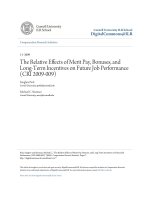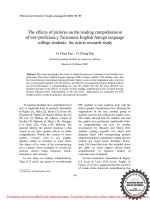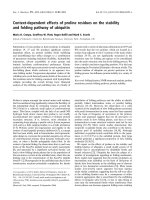The effects of leadership behaviors on employee loyalty through the mediation of job satisfaction
Bạn đang xem bản rút gọn của tài liệu. Xem và tải ngay bản đầy đủ của tài liệu tại đây (152.36 KB, 8 trang )
The Effects of Leadership Behaviors on Employee Loyalty
through the Mediation of Job Satisfaction – An Empirical
Study of Tourism Sector in Ho Chi Minh City, Vietnam
The Conceptual Research Model
Task Oriented
Leadership
Relation Oriented
Leadership
Change Oriented
Leadership
Ethics Oriented
Leadership
H1
Employee Job
Satisfaction
Employee Loyalty
H2
Participative
Leadership
Autocratic
Leadership
In order to obtain all the objectives and further analyses, this study hypothesizes that:
H1.1: Task-oriented leadership directly affects employee job satisfaction.
H1.2: Relation-oriented leadership directly affects employee job satisfaction.
H1.3: Change-oriented leadership directly affects employee job satisfaction.
H1.4: Ethical leadership directly affects employee job satisfaction.
H1.5: Participative leadership directly affects employee job satisfaction.
H1.6: Autocratic leadership directly affects employee job satisfaction.
H2.1: The effect of task-oriented leadership on employee loyalty is mediated by job
satisfaction.
H2.2: The effect of relation-oriented leadership on employee loyalty is mediated by job
satisfaction.
H2.3: The effect of change-oriented leadership on employee loyalty is mediated by job
satisfaction.
H2.4: The effect of ethics-oriented leadership on employee loyalty is mediated by job
satisfaction.
H2.5: The effect of participative leadership on employee loyalty is mediated by job
satisfaction.
H2.6: The effect of Autocratic leadership on employee loyalty is mediated by job satisfaction.
1
METHODOLOGY
Target population of this research was employees of tourism sector in HCMC. This target
population is the entire set of units for which the research data to be used. It can also be
inference involving in research work. The goal of using a target population is to conduct a
high percentage to sum up exactly result. The online structured questionnaires were
conveniently delivered to 748 employees who are working in hotels, restaurants, bars, clubs,
travel agencies, tourist transportation companies, and tourist attractions.
According to Gorsuch (1983), a minimum subject to item ratio of at least 5:1 in
Exploration Factors Analysis (EFA), but they also have stringent guidelines for when this
ratio is acceptable, and they both noted that higher ratios are generally better. Based on the
number of items used to measure dependent variables: employee loyalty (6 items) and
employee job satisfaction (10 items) and independent variables of ethical leadership,
autocratic leadership, task-oriented leadership, change-oriented leadership, relation-oriented
leadership, and participative leadership (42 items) of the research model of this study, the
ratio applied for EFA of dependent variables was 47:1 and the ratio for EFA of independent
variables was 18:1. Statistically, these ratios promise a better reliability and validity of
variables of this research.
Questionnaire design and data collection
The online structured questionnaire design was basing on measured variables derived from
the literature reviews for six independent variables and two dependent variables. Most
questions were set as statements with five-point Likert scale, ranging from 1 is “strongly
disagreed” to 5 is “strongly agreed”. The final questionnaire was completed and sent directly
to employees who are working in tourism sector in HCMC with directions and precise
contents to help them provide answers correctly.
Factor Analysis and Reliability
Factor analysis is used to decrease a large number of variables to minimize set of underlying factors
that summarize the essential information contained in the variables (Coakes, Steed, and Ong, 2008).
In this study, this technique is used to identify the relationship among item and factor to find out
what factor of leasership behavior affect employee loyalty through case of tourism industry in Ho Chi
Minh city, Viet Nam.
In statistics, research has several different reliability coefficients to investigate degree of confident
of collected data. Shortly, it measures the consistency of scores over time or across testers. The
most popular one is Cronbach’s alpha, which is based on the average correlation of items within a
test (standardized items) and average covariance among the items (not standardized items). Since
Cronbach’s alpha can be interpreted as a correlation coefficient, it ranges in value from 0 to 1
(Coakes, Steed, and Ong, 2008). According to Zikmund (2010), coefficient Cronbach’s alpha
interprets the value of scales.
Two exploratory factory analyses, which used the principal component extraction method and
Varimax rotation of 16 items of the dependent variables of employee loyalty and employee
2
job satisfactionand 42 items of the independent variables of leadership styles. Prior to
conducting the factor analysis with the SPSS, the data was screened by examining the
descriptive statistics on each item, inter-item correlations, and possible univariate and
multivariate assumption violations. From this initial assessment, all variables found to be
continuous, variable pairs appeared to be bivariate normally distributed, and all cases were
independent of one another. For this study, the exploratory factor analysis (EFA) procedure
was applied twice; once for the dependent variables and again for the group of six
independent variables. The Kaiser-Meyer-Olkin measure of sampling adequacy was .945 for
the dependent variables and .960 for the independent variables (according to Pallant, 2005, to
be significant, the value has to be .60 or above), indicating that the present data was suitable
for principal components analysis. Similarly, Bartlett’s test of sphericity (Bartlett, 1954) was
significant (p<.001), indicating sufficient correlation between the variables to proceed with
the analysis. Using the Kaiser-Guttman’s retention criterion of Eigenvalues greater than 1.0, a
two-factor solution provided the clearest extraction for the dependent variables, including 15
items (Guttman, 1954; Kaiser, 1974). The two factors of the dependent variables accounted
for 59% of the total variance and the Cronbach’s coefficients were .910 for employee job
satisfaction and .859 employee loyalty, indicating good reliability.
Table1: Summary of Dependent Variables with Reliability Coefficients
Factors
Factor1: Employee Job Satisfation (EMJOSA)
Factor 2: Employee Loyalty (EMLOY)
Numberof
Items
Cronbach’s
Alpha (N=748)
9
6
.910
.859
For the group of independent variables, five out of six factors were extracted which
respectively corresponded to the concepts of ethical leadership, autocratic leadership, taskoriented leadership, change-oriented leadership, and participative leadership of the research
model. All items of relation-oriented leadership were loading below the cut point of .50 so
researcher decided to exclude these low loading items. The Eigenvalues of five extracted
factors were greater than one and the total variance explained was 65% of the total variance
satisfying the requirement of being greater than 50%. Moreover, each factor generated from
the exploratory analysis had the high value of Cronbach’s Alpha (ranging from .853 to .925),
which implied the high reliability of the measurement scale for assessing the independent
variables.
Table 2: Summary of Independent Variables with Reliability Coefficients
Factors
Factor1: Ethical Leadership (ETLEAD)
Factor2: Autocratic Leadership (AUTOLE)
Factor3: Task-oriented Leadership (TASKOLE)
Factor4:Participative Leadership (PARLEAD)
Factor5: Change-oriented Leadership (CHANGOLE)
3
Numberof
Items
9
8
6
5
5
Cronbach’s
Alpha (N= 748)
.925
.923
.877
.886
.853
RESEARCH FINDINGS
Profile of Employees Involved in the Study
There were totally 748 employees working in Tourism Sector in HCM City participated in
this research through completing the questionnaires.
The structure of the study subjects are shown by the following synthesis table:
Variables
Gender
Marriage
status
Age
Education
level
Component of Samples
Variables
Male
335
44.8%
Female
413
55.2%
Single
579
77.4%
Married
169
22.6%
Under 18
From 18 to 23
From 24 to 30
From 31 to 45
From 46 to 65
High school
Vocational school
7
375
226
101
39
61
45
.9%
50.1%
30.2%
13.5%
5.2%
8.2%
6.0%
College
117
15.6%
University
Postgraduate
485
40
64.8%
5.3%
Component of Samples
526
70.3%
Low-level Manager
116
15.5%
Middle-level Manager
106
14.2%
Less than 1 year
253
33.8%
From 1 to 4 years
From 4 to 7 years
From 7 to 10 years
More than 10 years
Hotels
Restaurants - Bars - Clubs
Travel Agencies
Tourist Transportation
Companies
Tourist Attractions
313
78
37
67
261
279
114
41.8%
10.4%
4.9%
9.0%
34.9%
37.3%
15.2%
42
5.6%
52
7.0%
Job
position
Staff
Worked
for this
company
Working
field
Factors AffectingEmployee Loyalty
a) Correlations between variables
Table 3: Pearson Correlations between Variables of the Research Model
1. ETLEAD
2. AUTOLE
3. TASKOLE
4. PARLEAD
5. CHANGOLE
6. EMJOSA
Mean
SD.
EMLOY
.539*
-.130*
.543*
.533*
.529*
.658*
3.87
.673
1
1.000
-.259*
.690*
.745*
.743*
.680*
3.58
.681
2
3
4
5
1.000
-.130*
-.281*
-.191*
-.129*
2.61
.869
1.000
.650*
.685*
.617*
3.73
.646
1.000
.651*
.600*
3.63
.689
1.000
.620*
3.65
.666
Note: * Significant level at p < .05
In order to find out which factors had relationship with the variable of leadership and
employee loyalty, jop sastisfaction, pearson correlations were conducted. The table 3 show
that there were significant relationgships betwween the moderating variable of EMJOSA and
the independent variables: ETLEAD (r=.680,p<.05), AUTOLE (r=-.129,p<.05), TASKOLE
(r=.617,p<.05), PARLEAD (r=.600, p<.05) and CHANGOLE (r=.620,p<.05). This means
that the more value of leadership behaviors would improve employee job satisfaction. In the
table 3, we also see the relationships between the dependent variable of EMPLOY and the
4
independent variables: ETLEAD (r=.539, p<.05), AUTOLE (r =-.130,p<.05), TASKOLE (r=.543, p<0.05),
PARLEAD (r=.533,p<.05) and CHANGOLE (r=.529, p<.05).
Beside that, table 3 indicated that there was positive correlation between EMLOY and
EMJOSA (r=.658,p<.05). From this, the meaning is that higher employee job satisfaction
would lead to higher employee loyalty.
b) Direct and Indirect effects of Leadership Behaviors on Employee Loyalty
Table 4: Effect Coefficients between IVs and EMJOSA.
Variables
1. ETLEAD
2. AUTOLE
3. TASKOLE
4. PARLEAD
5. CHANGOLE
UnstandardizedCoefficients
t-value
4.027
7.729
1.976
4.979
3.118
3.781
.534
.345
.040
.199
.122
.155
Sig.
.000
.000
.049
.000
.002
.000
Note: Dependent Variable: EMJOSA: Employee Job Satisfaction
- Predictors: ETLEAD, AUTOLE, TASKOLE, PARLEAD, CHANGOLE
ANOVA
162.837
: F (5, 742) =
, Sig. =000, p < .05
- Model summary: R2= .523
The result in table 4, there are all 5 independent variables affect directly on the
EMJOSA: ETLEAD (β = .345, sig.<.05), AUTOLE(β = .040, sig.<.05),TASKOLE(β = .199,
sig.<.05),PARLEAD(β = .122, sig.<.05) and CHANGOLE(β = .345, sig.<.05).
Table 5: Effect Coefficients between IVs and EMLOY.
Variables
1. ETLEAD
2. AUTOLE
3. TASKOLE
4. PARLEAD
5. CHANGOLE
6. EMJOSA
UnstandardizedCoefficients
t-value
7.000
-.721
-.261
3.222
3.199
1.988
12.096
.992
-.035
-.006
.138
.133
.087
.470
Sig.
.000
.471
.794
.001
.001
.047
.000
Note: Dependent Variable: EMLOY: Employee Loyalty
- Predictors: ETLEAD, AUTOLE, TASKOLE, PARLEAD, CHANGOLE, EMJOSA
ANOVA
113.074
: F (6, 741) =
, Sig. =000, p < .05
- Model summary: R2= .478
The result in table 5, there were3 independent variables affect directly on the
EMPLOY: TASKOLE (β = .138, sig.<.05), PARLEAD (β = .133, sig.<.05) and CHANGOLE
(β = .087, sig.<.05). In addition, EMJOSA provided the direct effect on the EMLOY with (β
= .470, sig.<.05).
Indirect Effects of Leadership Behavior on Employee Loyalty.
5
Task-Oriented Leadership
Ethical Leadership
.
Autocratic Leadership
Participative Leadership
.
.
.
.
Employee Job
Satisfaction
Employee Loyalty
.
.
.
.
Change-Oriented Leadeship
Figure 1. Path coefficients of hypothesis testing
Note: All coefficients in the model were significant at the .005 level.
The total effect of independent variables on EMPLOY could be dividee into direct
effects and indirect effects. The direct effects of all independent variables on mediator as well
as dependent variable were the unstandardized coefficients and were considerd as the path
coefficients in the path model. The indirect effects of independent variables on the dependent
varialbe through the mediating variable of EMJOSA were the total products of the effecs of
those independent variables on the EMJOSA and the effects of the EMJOSA on the
dependent variable of EMPLOY.
The result of this study showed that Employee Loyalty was affected directly by three
independent variables. Beside that, all independent variables of leadership through the
mediating variable of EMJOSA had inderect effects on EMPLOY as shown in Figure 1 and
Table 6.
d) Significant of the Indirect Effects
Table VI showed the results of the bootstrapping method recommended by Preacher and
Hayes (2008) to test the significance of indirect effects or mediations. The output provided
the bootstrapped confidence intervals (at the 95%). If there is a zero (0) lies within the
interval range between the lower boundary (LL) and the upper boundary (UL), then we can
conclude that, with 95% confidence, there is no mediation or indirect effect. On the other
hand, if zero does not occur between the LL and the UL, then we can conclude that, with 95%
confidence, the mediation or indirect effect is significant (Preacher and Hayes, 2004). As can
be seen in the output of Table V, the indirect effects of ETLEAD, AUTOLE, TASKOLE,
PARLED and CHANGOLE were estimated to lie between .1224 (LL) and .2045 (UL), .0033
(LL) and .0353 (UL), .0605 (LL) and .1273 (UL), .0266 (LL) and .0890 (UL), .0404 (LL) and
.1067 (UL), respectively. Therefore, it was concluded thatthe indirect effects of ETLEAD,
6
AUTOLE, TASKOLE, PARLED and CHANGOLE on EMLOY were significantly, thus the
mediation of EMJOSA in this study was true.
Table 6: Direct, Indirect, and Total Causal Effects
Variables
1. ETLEAD
2. AUTOLE
3. TASKOLE
4. PARLEAD
5. CHANGOLE
6. EMJOSA
Total
Direct
------.138
.133
.087
.470
.828
Causal effects
Indirect
.162
.019
.094
.057
.073
---.405
Total
.162
.019
.232
.190
.160
.470
1.233
LL
.1224
.0033
.0605
.0266
.0404
UL
.2045
.0353
.1273
.0890
.1067
DISCUSSIONS AND RECOMMENDATIONS
a)
Practical Recommendations and Contributions to Companies in Tourism Sector in
HCM City
Firstly, due to all of the results above, this study concluded that employee job satisfation
was the most important factor that effected to employee Loyalty in tourism sector in Ho Chi
Minh City. From this result, any enterprises in tourism sector need interest in the satisfaction
of employees to strengthen their loyalty to your company. On a monthly basis, the Company
has regular monthly survey of internal secret companies to understand the aspirations, the
satisfaction of employees for leadership on different aspects. From the regular survey, the
company leadership adjustments in behavior, corporate culture to increasingly facilitate the
development of employees and thereby improve their loyalty to enterprise
Secondly, the task-oriented Leadership also has the next biggest impact on employee
loyalty. This impact includes direct impacts and indirect through the empoyee job
satisfaction. Thus, the leader in every company needs to have qualifications orientation,
leading to its employees. Besides that, leaders also need to complete the mission to strengthen
trust, satisfaction of employees. Through it, they have a long-term commitment to the
company.
Thirdly, besides the two factors mentioned above, several factors also have a major
impact on employee loyalty, in a way that directly and indirectly through satisfaction. The
factors may include participative and change- oriented leadership. From the results of that
study, the leaders of companies of tourism sector in HCM City also needs the participation,
sticking closely to the work of each employee. Besides, each of the leaders themselves also
need frequent adjustments, changing to more environmentally appropriate personnel within
the companies. Thereby, each company's employees are also more satisfaction in relation to
leadership and engagement with their workplaces
b) Applied Implications
Through the study, the authors evaluated these factors in relationship management with
the greatest impact on the loyalty of employees in the tourism sector in Ho Chi Minh City.
From that analysis, leading travel companies in HCM City can adjust their own behavior, to
7
improve the working environment in order to create long-term adherence to the staff with the
company. The characteristics of the tourism sector, each employee become a logo to promote
the image of the company to the customer. The retention of experienced staff in the field of
tourism is an important factor for the development of the company.
Thus, research findings have contributed to the travel companies in HCM City in improving
the relationship of leadership to create trust and loyalty of staff.The research also areapplied
in other tourist cities such as Hanoi, Da Nang, Nha Trang ... as well as in Vietnam
8









